RBSE Solutions for Class 6 Maths Chapter 3 Whole Numbers In Text Exercise is part of RBSE Solutions for Class 6 Maths. Here we have given Rajasthan Board RBSE Class 6 Maths Chapter 3 Whole Numbers In Text Exercise.
| Board | RBSE |
| Textbook | SIERT, Rajasthan |
| Class | Class 6 |
| Subject | Maths |
| Chapter | Chapter 3 |
| Chapter Name | Whole Numbers |
| Exercise | In Text Exercise |
| Number of Questions | 16 |
| Category | RBSE Solutions |
Rajasthan Board RBSE Class 6 Maths Chapter 3 Whole Numbers In Text Exercise
Page. No. 39
Question 1.
Complete the following (RBSESolutions.com) table for osure property.
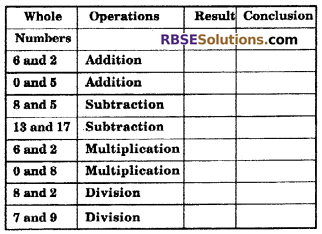
Solution.
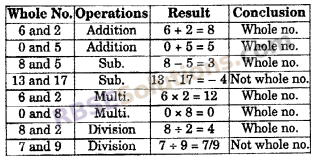
![]()
Page. No. 42
Question 1.
Take set of 3-3 numbers and test properties (RBSESolutions.com) of associativity on the operations of addition and multiplication respectively.
Solution.
Adding under associativity
(22 + 7) + 6 = 29 + 6 = 35 or 22 + (7 + 6) = 22 + 13 = 35
∴ In addition, associativity occurs.
Multiplying under associativity
(22 × 7) × 6 = 154 × 6 = 924 or 22 × (7 × 6) = 22 × 42 = 924
∴ In multiplication, associativity occurs.
Think and Tell
Page No. 35
Question 1.
6 – 6 = …. or 5 – 5 = …. or 10 – 10 = ….
Solution.
When a number is subtracted (RBSESolutions.com) itself, then result obtained is zero (0).
6 – 6 = 0 or 5 – 5 = 0 or 10 – 10 = 0
Page. No. 35
Question 1.
Fill in the blanks with suitable numbers
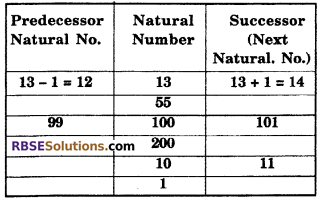
Solution.
Completing the table
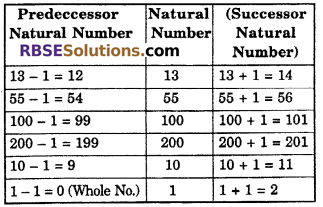
Note :
Number 1 bas no predecessor natural number.
Pg. No. 35
Question 1.
From the following line, can you tell which (RBSESolutions.com) number is bigger ?
![]()
Solution.
Yes, on number line, numbers are written in ascending order from zero towards right, e.g., > 0,2 > 1 ,10 > 9
Question 2.
Think, number on left side of any number on number line will be smaller or greater.
Solution.
Smaller
![]()
Page No. 36
Looking at the following table (RBSESolutions.com) find out true or false.

Solution.
1. T
2. F
3. T
4. T
5. T
Question 1.
Practice the operations of simple addition, subtraction, (RBSESolutions.com) multiplication and division on number line.
Solution.
Adding 8 + 4 on number line –
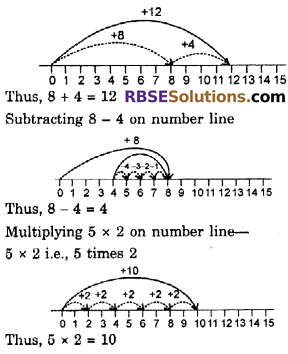
Question 2.
Practice, by taking (RBSESolutions.com) different numbers for addition on number line.
Solution.
(i) 7 + 6
(ii) 11 + 4
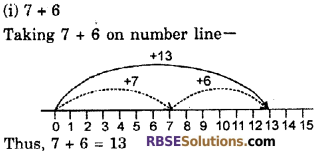
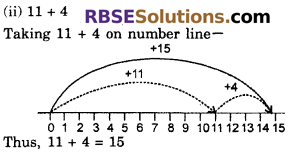
Question 3.
Practice, by taking different numbers for subtraction (RBSESolutions.com) on number line.
Solution.
(i) 6 – 2
(ii) 9 – 6
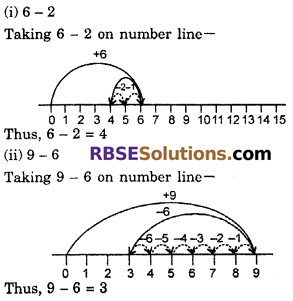
Pg. No. 38
Question 1.
Under closure (RBSESolutions.com) property, take some pair of whole numbers. Is their sum also a whole number? Did you find any pair whose sum is not a whole number?
Solution.
Under closure property, adding some whole numbers –
2 + 9 = 11, Whole number
8 + 15 = 23, Whole number
14 + 3 = 17, Whole number
16 + 4 = 20, Whole number
11 + 7 = 18, Whole number
Yes, on adding whole numbers, result is always whole number.
No, there is no pair whose sum is not a whole number.
Question 2.
Whole numbers closed (RBSESolutions.com) under subtraction.
Solution.
No, whole numbers are not closed under subtraction (may or may not).
e.g., 4 – 2 = 2, Whole number
7 – 12 = – 5, Not whole number
![]()
Pg. No. 40
Question 1.
Take five more pairs of numbers and test the fact. Does sum of any pair changed after changing their order?
Solution.
Taking five number pairs –
(i) 17 + 9 = 26 or 9 + 17 = 26 ⇒ 26 = 26
(ii) 12 + 1 = 13 or 1 + 12 = 13 ⇒ 13 = 13
(iii) 4 + 25 = 29 or 25 + 4 = 29 ⇒ 29 = 29
(iv) 7 + 3 = 10 or 3 + 7 = 10 ⇒ 10 = 10
(v) 6 + 19 = 25 or 19 + 6 = 25 ⇒ 25 = 25
No, any pair does not change after changing their order.
Pg. No. 41
Question 1.
Complete (RBSESolutions.com) the table

Solution.
Completing the table
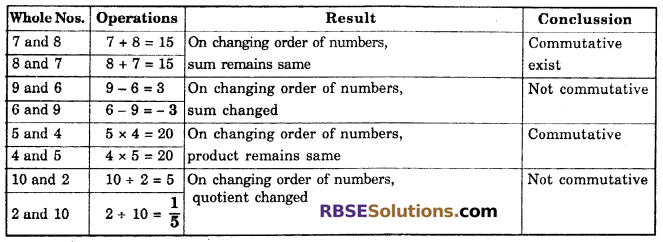
Question 2.
Is property of association applied for subtraction?
Solution.
No, property of association does not apply for subtraction
Pg. No. 42
Question 1.
Complete the (RBSESolutions.com) following table.
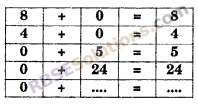
Solution.
Completing the table –
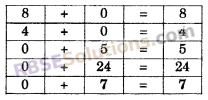
Question 2.
Fill the table.
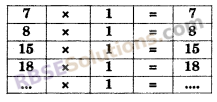
Solution.
Completing the table –
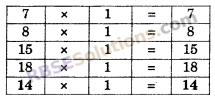
![]()
We hope the RBSE Solutions for Class 6 Maths Chapter 3 Whole Numbers In Text Exercise will help you. If you have any query regarding Rajasthan Board RBSE Class 6 Maths Chapter 3 Whole Numbers In Text Exercise, drop a comment below and we will get back to you at the earliest.